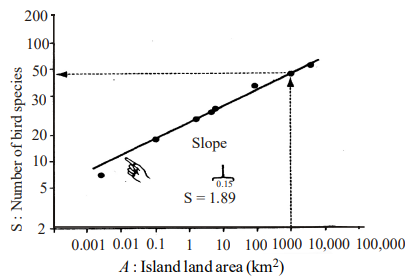Question
Medium
Solving time: 3 mins
Using the figure, determine the percentage of bird species that will be lost if the island's inhabitable land area is reduced from 100,000 to 1 .

Found 5 tutors discussing this question
Discuss this question LIVE
12 mins ago
 Text solution
Text solution Verified
Verified
93 percent of the bird species will be lost.
Was this solution helpful?
102
Share
Report

One destination to cover all your homework and assignment needs
Learn Practice Revision Succeed

Instant 1:1 help, 24x7
60, 000+ Expert tutors

Textbook solutions
Big idea maths, McGraw-Hill Education etc

Essay review
Get expert feedback on your essay

Schedule classes
High dosage tutoring from Dedicated 3 experts
Practice questions from Xtract Objective Biology for NEET (Disha)
Question 2
Easy
Views: 5,808
Practice more questions from Biodiversity and Conservation
Question 2
Hard
Views: 5,502
Question 3
Medium
Views: 5,690
Question 4
Medium
Views: 5,688
Assertion : Tropical rain forests are disappearing fast from developing countries such as India.
Reason : No value is attached to these forests because these are poor in biodiversity.
Practice questions on similar concepts asked by Filo students
Question 1
Views: 5,899
Question 2
Views: 5,786
Question 3
Views: 5,526
Question 4
Views: 5,817


Stuck on the question or explanation?
Connect with our Biology tutors online and get step by step solution of this question.
231 students are taking LIVE classes
| Question Text | Using the figure, determine the percentage of bird species that will be lost if the island's inhabitable land area is reduced from 100,000 to 1 . |
| Topic | Biodiversity and Conservation |
| Subject | Biology |
| Class | Class 12 |
| Answer Type | Text solution:1 |
| Upvotes | 102 |





